Organisational Learning and Change Project: ABC Healthcare Report
VerifiedAdded on 2023/01/19
|12
|3367
|98
Report
AI Summary
This report examines the change management strategies proposed for ABC Healthcare Pvt. Ltd., a leading healthcare provider in Australia facing increased competition and the need for technological advancements. The report begins with a company background and case overview, highlighting the shift from traditional pen-and-paper methods to the implementation of an ERP business suite. It then analyzes internal and external factors driving the need for change, including market competition, technological advancements, and social changes, as well as internal factors like organizational structure, learning needs, and communication challenges. The report explores various change management theories, including Lewin's, McKinsey's 7-S, and Kotter's, ultimately recommending Kotter's theory as the most suitable approach. The report details a step-by-step change strategy based on Kotter's model, including creating a sense of urgency, building a coalition, formulating and communicating a strategic vision, and removing obstacles. The report emphasizes the importance of employee buy-in and provides recommendations for successful ERP implementation, supporting the transition towards improved efficiency and patient care. The analysis is based on the assignment brief and is a comprehensive overview of the change management project.
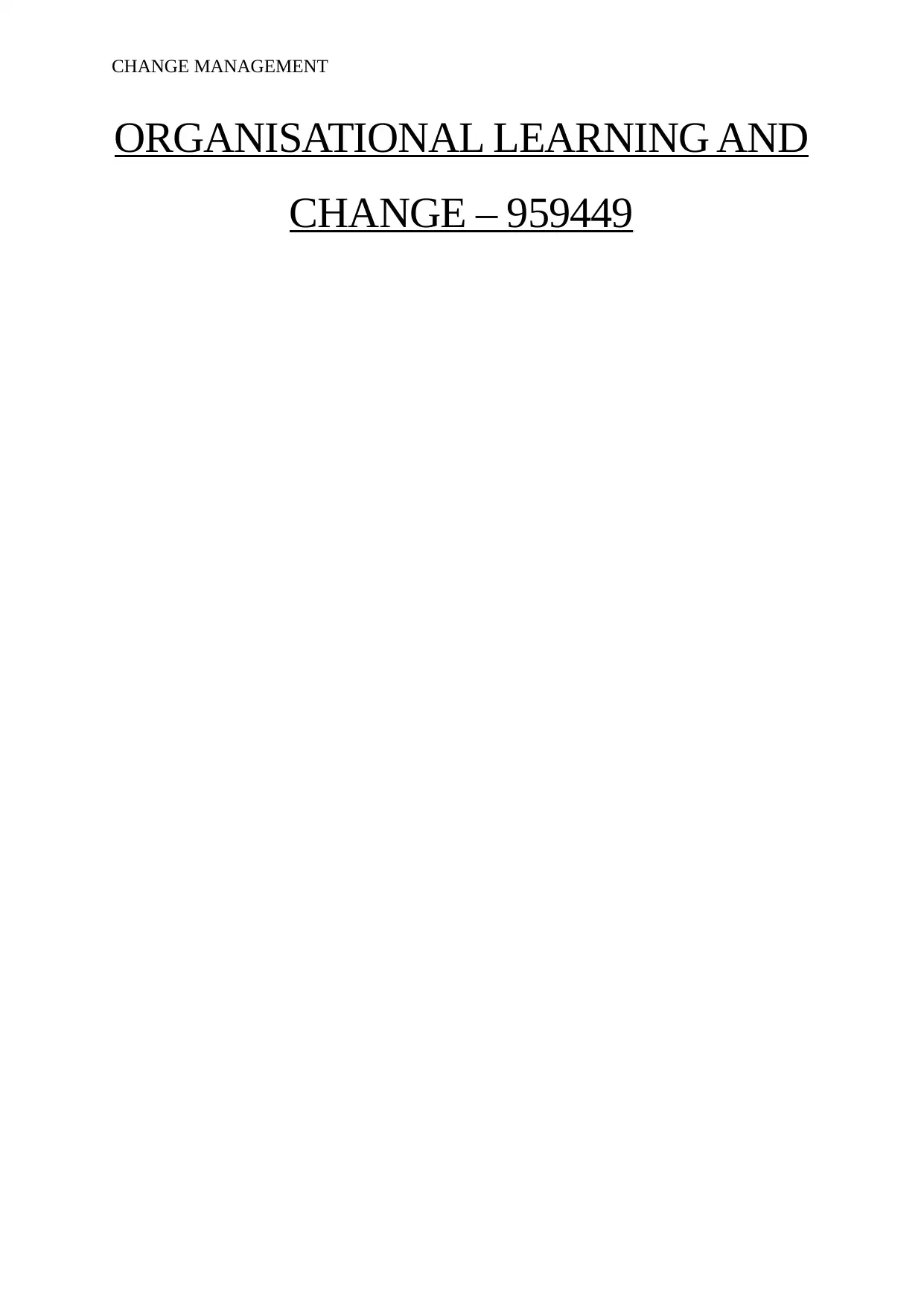
CHANGE MANAGEMENT
ORGANISATIONAL LEARNING AND
CHANGE – 959449
ORGANISATIONAL LEARNING AND
CHANGE – 959449
Paraphrase This Document
Need a fresh take? Get an instant paraphrase of this document with our AI Paraphraser
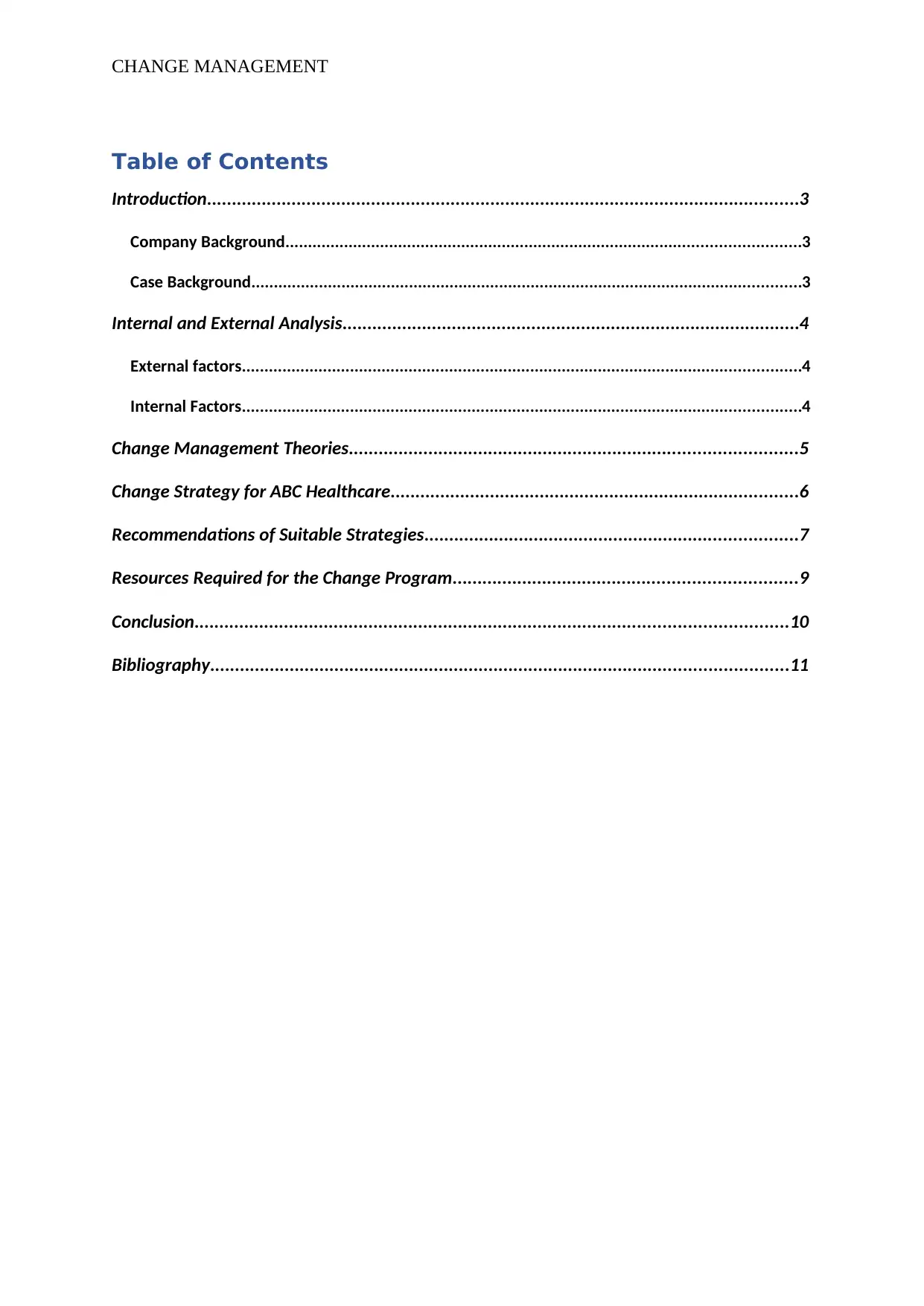
CHANGE MANAGEMENT
Table of Contents
Introduction.......................................................................................................................3
Company Background..................................................................................................................3
Case Background..........................................................................................................................3
Internal and External Analysis............................................................................................4
External factors............................................................................................................................4
Internal Factors............................................................................................................................4
Change Management Theories..........................................................................................5
Change Strategy for ABC Healthcare..................................................................................6
Recommendations of Suitable Strategies...........................................................................7
Resources Required for the Change Program.....................................................................9
Conclusion.......................................................................................................................10
Bibliography....................................................................................................................11
Table of Contents
Introduction.......................................................................................................................3
Company Background..................................................................................................................3
Case Background..........................................................................................................................3
Internal and External Analysis............................................................................................4
External factors............................................................................................................................4
Internal Factors............................................................................................................................4
Change Management Theories..........................................................................................5
Change Strategy for ABC Healthcare..................................................................................6
Recommendations of Suitable Strategies...........................................................................7
Resources Required for the Change Program.....................................................................9
Conclusion.......................................................................................................................10
Bibliography....................................................................................................................11
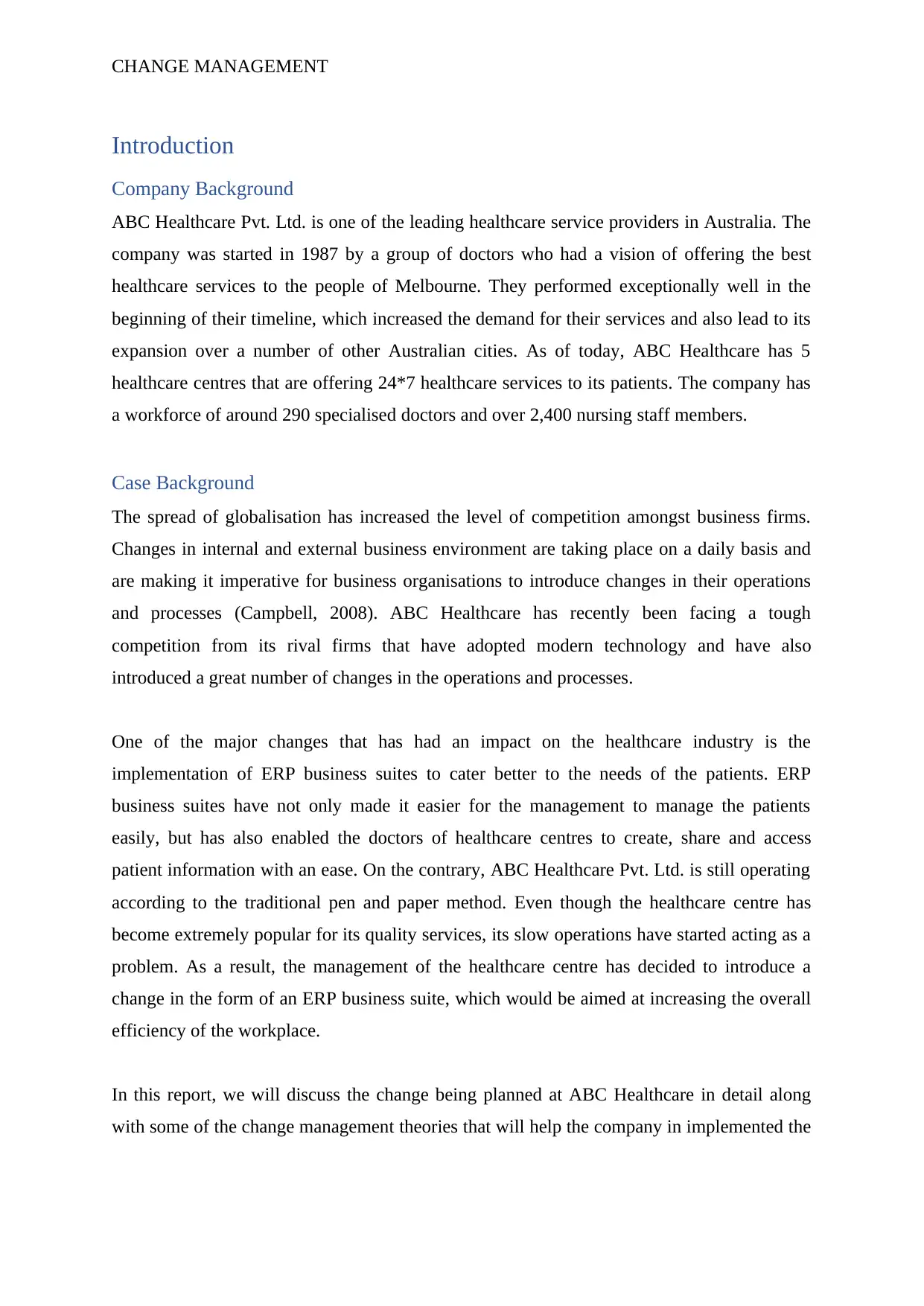
CHANGE MANAGEMENT
Introduction
Company Background
ABC Healthcare Pvt. Ltd. is one of the leading healthcare service providers in Australia. The
company was started in 1987 by a group of doctors who had a vision of offering the best
healthcare services to the people of Melbourne. They performed exceptionally well in the
beginning of their timeline, which increased the demand for their services and also lead to its
expansion over a number of other Australian cities. As of today, ABC Healthcare has 5
healthcare centres that are offering 24*7 healthcare services to its patients. The company has
a workforce of around 290 specialised doctors and over 2,400 nursing staff members.
Case Background
The spread of globalisation has increased the level of competition amongst business firms.
Changes in internal and external business environment are taking place on a daily basis and
are making it imperative for business organisations to introduce changes in their operations
and processes (Campbell, 2008). ABC Healthcare has recently been facing a tough
competition from its rival firms that have adopted modern technology and have also
introduced a great number of changes in the operations and processes.
One of the major changes that has had an impact on the healthcare industry is the
implementation of ERP business suites to cater better to the needs of the patients. ERP
business suites have not only made it easier for the management to manage the patients
easily, but has also enabled the doctors of healthcare centres to create, share and access
patient information with an ease. On the contrary, ABC Healthcare Pvt. Ltd. is still operating
according to the traditional pen and paper method. Even though the healthcare centre has
become extremely popular for its quality services, its slow operations have started acting as a
problem. As a result, the management of the healthcare centre has decided to introduce a
change in the form of an ERP business suite, which would be aimed at increasing the overall
efficiency of the workplace.
In this report, we will discuss the change being planned at ABC Healthcare in detail along
with some of the change management theories that will help the company in implemented the
Introduction
Company Background
ABC Healthcare Pvt. Ltd. is one of the leading healthcare service providers in Australia. The
company was started in 1987 by a group of doctors who had a vision of offering the best
healthcare services to the people of Melbourne. They performed exceptionally well in the
beginning of their timeline, which increased the demand for their services and also lead to its
expansion over a number of other Australian cities. As of today, ABC Healthcare has 5
healthcare centres that are offering 24*7 healthcare services to its patients. The company has
a workforce of around 290 specialised doctors and over 2,400 nursing staff members.
Case Background
The spread of globalisation has increased the level of competition amongst business firms.
Changes in internal and external business environment are taking place on a daily basis and
are making it imperative for business organisations to introduce changes in their operations
and processes (Campbell, 2008). ABC Healthcare has recently been facing a tough
competition from its rival firms that have adopted modern technology and have also
introduced a great number of changes in the operations and processes.
One of the major changes that has had an impact on the healthcare industry is the
implementation of ERP business suites to cater better to the needs of the patients. ERP
business suites have not only made it easier for the management to manage the patients
easily, but has also enabled the doctors of healthcare centres to create, share and access
patient information with an ease. On the contrary, ABC Healthcare Pvt. Ltd. is still operating
according to the traditional pen and paper method. Even though the healthcare centre has
become extremely popular for its quality services, its slow operations have started acting as a
problem. As a result, the management of the healthcare centre has decided to introduce a
change in the form of an ERP business suite, which would be aimed at increasing the overall
efficiency of the workplace.
In this report, we will discuss the change being planned at ABC Healthcare in detail along
with some of the change management theories that will help the company in implemented the
⊘ This is a preview!⊘
Do you want full access?
Subscribe today to unlock all pages.

Trusted by 1+ million students worldwide
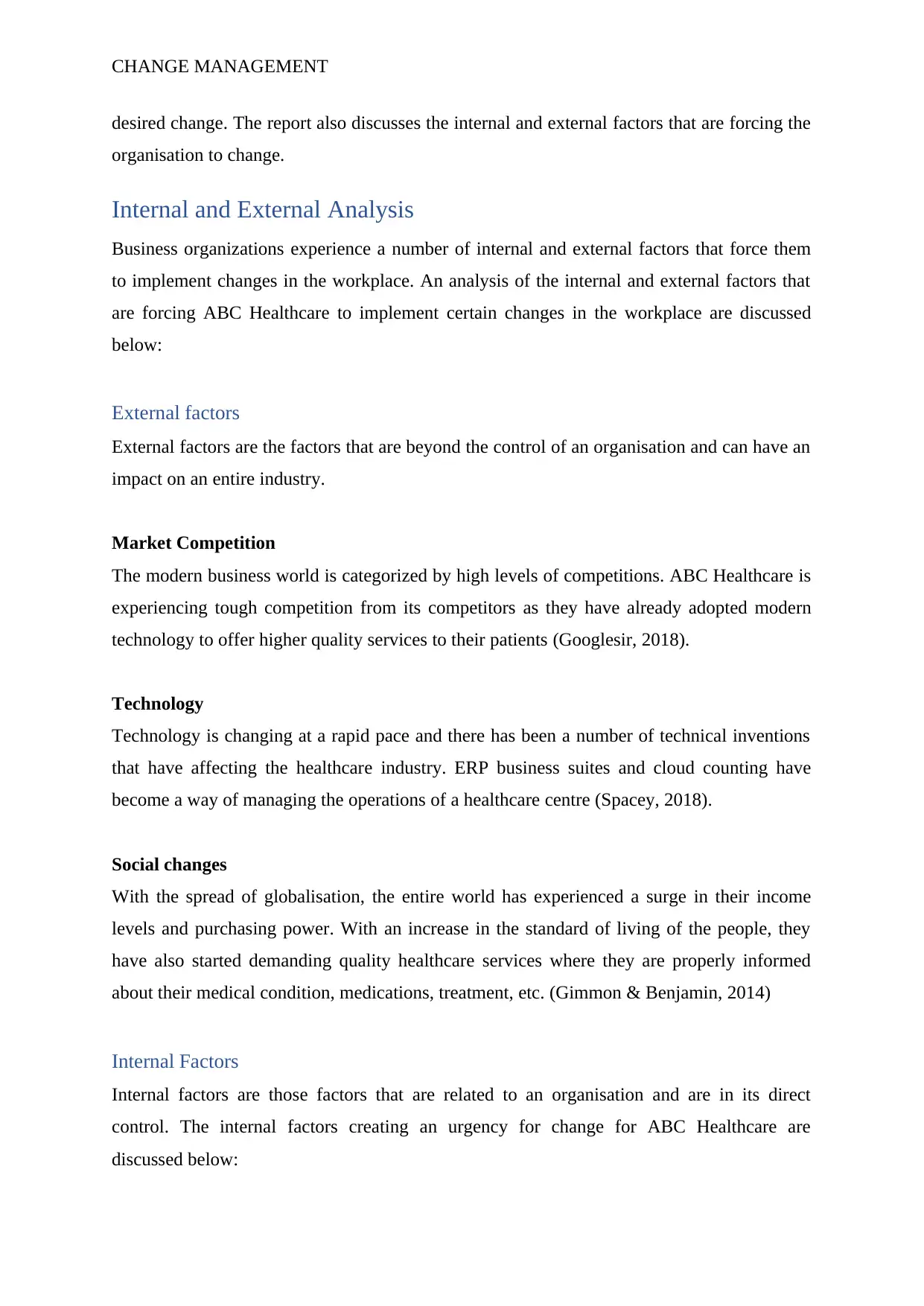
CHANGE MANAGEMENT
desired change. The report also discusses the internal and external factors that are forcing the
organisation to change.
Internal and External Analysis
Business organizations experience a number of internal and external factors that force them
to implement changes in the workplace. An analysis of the internal and external factors that
are forcing ABC Healthcare to implement certain changes in the workplace are discussed
below:
External factors
External factors are the factors that are beyond the control of an organisation and can have an
impact on an entire industry.
Market Competition
The modern business world is categorized by high levels of competitions. ABC Healthcare is
experiencing tough competition from its competitors as they have already adopted modern
technology to offer higher quality services to their patients (Googlesir, 2018).
Technology
Technology is changing at a rapid pace and there has been a number of technical inventions
that have affecting the healthcare industry. ERP business suites and cloud counting have
become a way of managing the operations of a healthcare centre (Spacey, 2018).
Social changes
With the spread of globalisation, the entire world has experienced a surge in their income
levels and purchasing power. With an increase in the standard of living of the people, they
have also started demanding quality healthcare services where they are properly informed
about their medical condition, medications, treatment, etc. (Gimmon & Benjamin, 2014)
Internal Factors
Internal factors are those factors that are related to an organisation and are in its direct
control. The internal factors creating an urgency for change for ABC Healthcare are
discussed below:
desired change. The report also discusses the internal and external factors that are forcing the
organisation to change.
Internal and External Analysis
Business organizations experience a number of internal and external factors that force them
to implement changes in the workplace. An analysis of the internal and external factors that
are forcing ABC Healthcare to implement certain changes in the workplace are discussed
below:
External factors
External factors are the factors that are beyond the control of an organisation and can have an
impact on an entire industry.
Market Competition
The modern business world is categorized by high levels of competitions. ABC Healthcare is
experiencing tough competition from its competitors as they have already adopted modern
technology to offer higher quality services to their patients (Googlesir, 2018).
Technology
Technology is changing at a rapid pace and there has been a number of technical inventions
that have affecting the healthcare industry. ERP business suites and cloud counting have
become a way of managing the operations of a healthcare centre (Spacey, 2018).
Social changes
With the spread of globalisation, the entire world has experienced a surge in their income
levels and purchasing power. With an increase in the standard of living of the people, they
have also started demanding quality healthcare services where they are properly informed
about their medical condition, medications, treatment, etc. (Gimmon & Benjamin, 2014)
Internal Factors
Internal factors are those factors that are related to an organisation and are in its direct
control. The internal factors creating an urgency for change for ABC Healthcare are
discussed below:
Paraphrase This Document
Need a fresh take? Get an instant paraphrase of this document with our AI Paraphraser
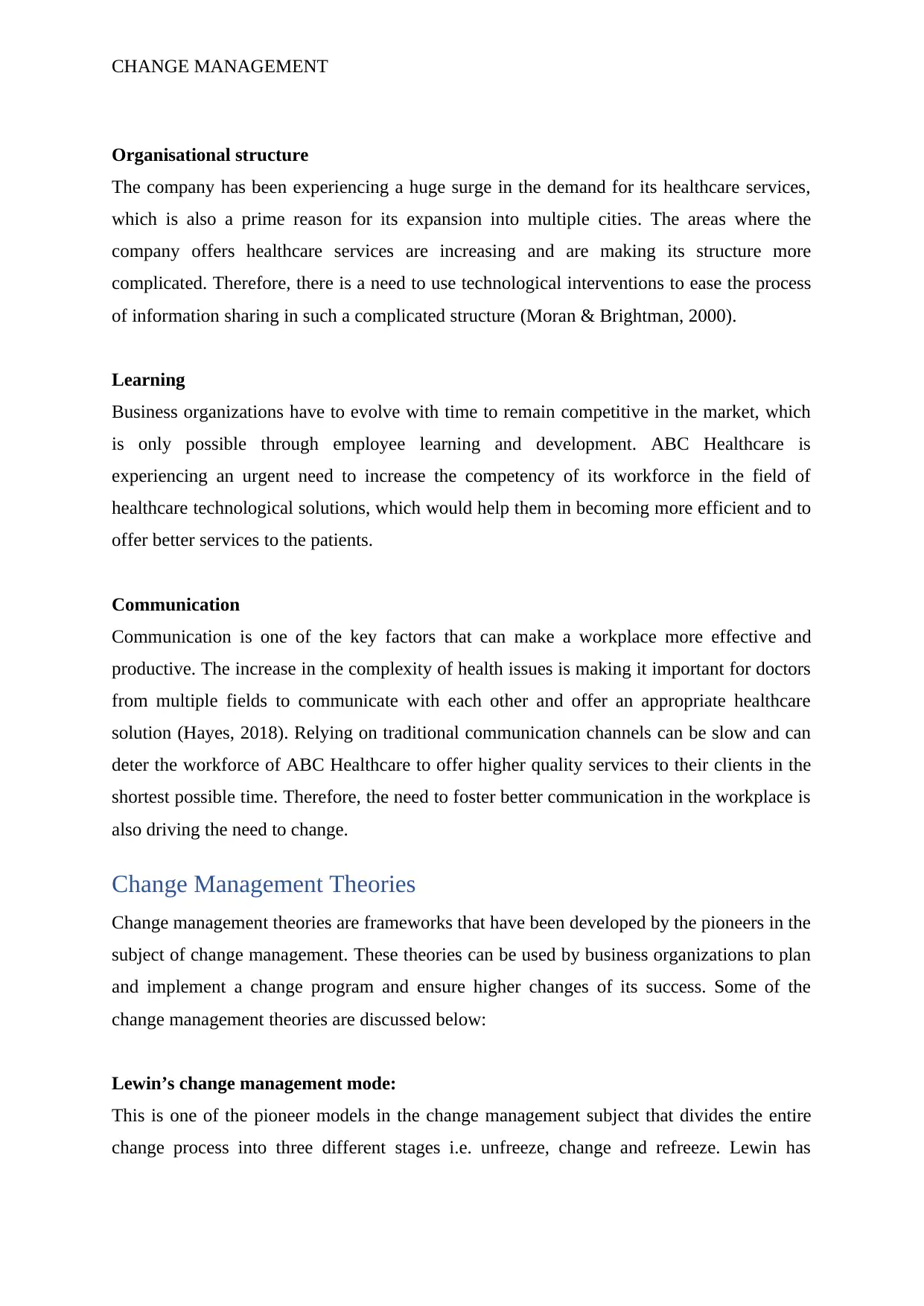
CHANGE MANAGEMENT
Organisational structure
The company has been experiencing a huge surge in the demand for its healthcare services,
which is also a prime reason for its expansion into multiple cities. The areas where the
company offers healthcare services are increasing and are making its structure more
complicated. Therefore, there is a need to use technological interventions to ease the process
of information sharing in such a complicated structure (Moran & Brightman, 2000).
Learning
Business organizations have to evolve with time to remain competitive in the market, which
is only possible through employee learning and development. ABC Healthcare is
experiencing an urgent need to increase the competency of its workforce in the field of
healthcare technological solutions, which would help them in becoming more efficient and to
offer better services to the patients.
Communication
Communication is one of the key factors that can make a workplace more effective and
productive. The increase in the complexity of health issues is making it important for doctors
from multiple fields to communicate with each other and offer an appropriate healthcare
solution (Hayes, 2018). Relying on traditional communication channels can be slow and can
deter the workforce of ABC Healthcare to offer higher quality services to their clients in the
shortest possible time. Therefore, the need to foster better communication in the workplace is
also driving the need to change.
Change Management Theories
Change management theories are frameworks that have been developed by the pioneers in the
subject of change management. These theories can be used by business organizations to plan
and implement a change program and ensure higher changes of its success. Some of the
change management theories are discussed below:
Lewin’s change management mode:
This is one of the pioneer models in the change management subject that divides the entire
change process into three different stages i.e. unfreeze, change and refreeze. Lewin has
Organisational structure
The company has been experiencing a huge surge in the demand for its healthcare services,
which is also a prime reason for its expansion into multiple cities. The areas where the
company offers healthcare services are increasing and are making its structure more
complicated. Therefore, there is a need to use technological interventions to ease the process
of information sharing in such a complicated structure (Moran & Brightman, 2000).
Learning
Business organizations have to evolve with time to remain competitive in the market, which
is only possible through employee learning and development. ABC Healthcare is
experiencing an urgent need to increase the competency of its workforce in the field of
healthcare technological solutions, which would help them in becoming more efficient and to
offer better services to the patients.
Communication
Communication is one of the key factors that can make a workplace more effective and
productive. The increase in the complexity of health issues is making it important for doctors
from multiple fields to communicate with each other and offer an appropriate healthcare
solution (Hayes, 2018). Relying on traditional communication channels can be slow and can
deter the workforce of ABC Healthcare to offer higher quality services to their clients in the
shortest possible time. Therefore, the need to foster better communication in the workplace is
also driving the need to change.
Change Management Theories
Change management theories are frameworks that have been developed by the pioneers in the
subject of change management. These theories can be used by business organizations to plan
and implement a change program and ensure higher changes of its success. Some of the
change management theories are discussed below:
Lewin’s change management mode:
This is one of the pioneer models in the change management subject that divides the entire
change process into three different stages i.e. unfreeze, change and refreeze. Lewin has
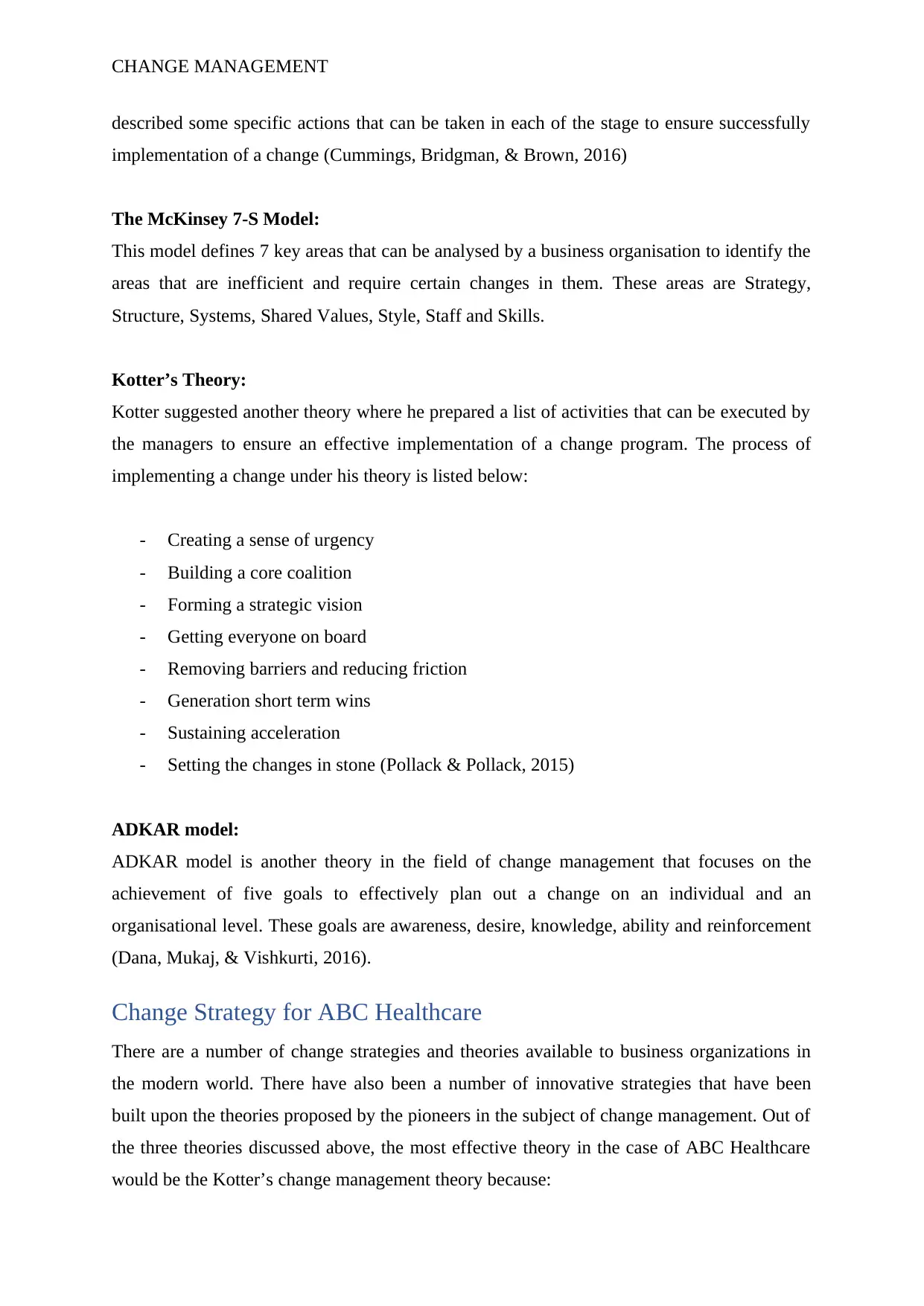
CHANGE MANAGEMENT
described some specific actions that can be taken in each of the stage to ensure successfully
implementation of a change (Cummings, Bridgman, & Brown, 2016)
The McKinsey 7-S Model:
This model defines 7 key areas that can be analysed by a business organisation to identify the
areas that are inefficient and require certain changes in them. These areas are Strategy,
Structure, Systems, Shared Values, Style, Staff and Skills.
Kotter’s Theory:
Kotter suggested another theory where he prepared a list of activities that can be executed by
the managers to ensure an effective implementation of a change program. The process of
implementing a change under his theory is listed below:
- Creating a sense of urgency
- Building a core coalition
- Forming a strategic vision
- Getting everyone on board
- Removing barriers and reducing friction
- Generation short term wins
- Sustaining acceleration
- Setting the changes in stone (Pollack & Pollack, 2015)
ADKAR model:
ADKAR model is another theory in the field of change management that focuses on the
achievement of five goals to effectively plan out a change on an individual and an
organisational level. These goals are awareness, desire, knowledge, ability and reinforcement
(Dana, Mukaj, & Vishkurti, 2016).
Change Strategy for ABC Healthcare
There are a number of change strategies and theories available to business organizations in
the modern world. There have also been a number of innovative strategies that have been
built upon the theories proposed by the pioneers in the subject of change management. Out of
the three theories discussed above, the most effective theory in the case of ABC Healthcare
would be the Kotter’s change management theory because:
described some specific actions that can be taken in each of the stage to ensure successfully
implementation of a change (Cummings, Bridgman, & Brown, 2016)
The McKinsey 7-S Model:
This model defines 7 key areas that can be analysed by a business organisation to identify the
areas that are inefficient and require certain changes in them. These areas are Strategy,
Structure, Systems, Shared Values, Style, Staff and Skills.
Kotter’s Theory:
Kotter suggested another theory where he prepared a list of activities that can be executed by
the managers to ensure an effective implementation of a change program. The process of
implementing a change under his theory is listed below:
- Creating a sense of urgency
- Building a core coalition
- Forming a strategic vision
- Getting everyone on board
- Removing barriers and reducing friction
- Generation short term wins
- Sustaining acceleration
- Setting the changes in stone (Pollack & Pollack, 2015)
ADKAR model:
ADKAR model is another theory in the field of change management that focuses on the
achievement of five goals to effectively plan out a change on an individual and an
organisational level. These goals are awareness, desire, knowledge, ability and reinforcement
(Dana, Mukaj, & Vishkurti, 2016).
Change Strategy for ABC Healthcare
There are a number of change strategies and theories available to business organizations in
the modern world. There have also been a number of innovative strategies that have been
built upon the theories proposed by the pioneers in the subject of change management. Out of
the three theories discussed above, the most effective theory in the case of ABC Healthcare
would be the Kotter’s change management theory because:
⊘ This is a preview!⊘
Do you want full access?
Subscribe today to unlock all pages.

Trusted by 1+ million students worldwide
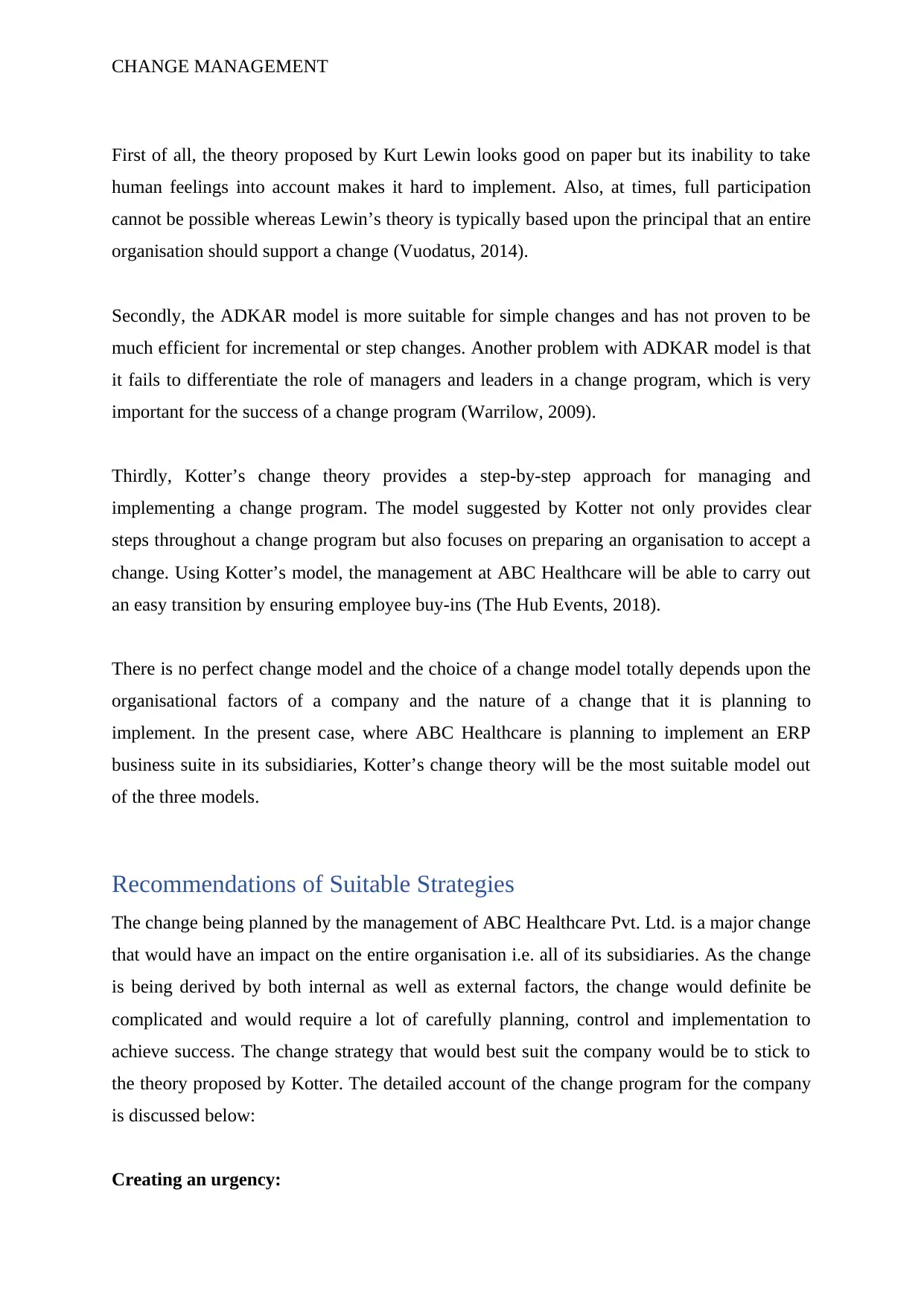
CHANGE MANAGEMENT
First of all, the theory proposed by Kurt Lewin looks good on paper but its inability to take
human feelings into account makes it hard to implement. Also, at times, full participation
cannot be possible whereas Lewin’s theory is typically based upon the principal that an entire
organisation should support a change (Vuodatus, 2014).
Secondly, the ADKAR model is more suitable for simple changes and has not proven to be
much efficient for incremental or step changes. Another problem with ADKAR model is that
it fails to differentiate the role of managers and leaders in a change program, which is very
important for the success of a change program (Warrilow, 2009).
Thirdly, Kotter’s change theory provides a step-by-step approach for managing and
implementing a change program. The model suggested by Kotter not only provides clear
steps throughout a change program but also focuses on preparing an organisation to accept a
change. Using Kotter’s model, the management at ABC Healthcare will be able to carry out
an easy transition by ensuring employee buy-ins (The Hub Events, 2018).
There is no perfect change model and the choice of a change model totally depends upon the
organisational factors of a company and the nature of a change that it is planning to
implement. In the present case, where ABC Healthcare is planning to implement an ERP
business suite in its subsidiaries, Kotter’s change theory will be the most suitable model out
of the three models.
Recommendations of Suitable Strategies
The change being planned by the management of ABC Healthcare Pvt. Ltd. is a major change
that would have an impact on the entire organisation i.e. all of its subsidiaries. As the change
is being derived by both internal as well as external factors, the change would definite be
complicated and would require a lot of carefully planning, control and implementation to
achieve success. The change strategy that would best suit the company would be to stick to
the theory proposed by Kotter. The detailed account of the change program for the company
is discussed below:
Creating an urgency:
First of all, the theory proposed by Kurt Lewin looks good on paper but its inability to take
human feelings into account makes it hard to implement. Also, at times, full participation
cannot be possible whereas Lewin’s theory is typically based upon the principal that an entire
organisation should support a change (Vuodatus, 2014).
Secondly, the ADKAR model is more suitable for simple changes and has not proven to be
much efficient for incremental or step changes. Another problem with ADKAR model is that
it fails to differentiate the role of managers and leaders in a change program, which is very
important for the success of a change program (Warrilow, 2009).
Thirdly, Kotter’s change theory provides a step-by-step approach for managing and
implementing a change program. The model suggested by Kotter not only provides clear
steps throughout a change program but also focuses on preparing an organisation to accept a
change. Using Kotter’s model, the management at ABC Healthcare will be able to carry out
an easy transition by ensuring employee buy-ins (The Hub Events, 2018).
There is no perfect change model and the choice of a change model totally depends upon the
organisational factors of a company and the nature of a change that it is planning to
implement. In the present case, where ABC Healthcare is planning to implement an ERP
business suite in its subsidiaries, Kotter’s change theory will be the most suitable model out
of the three models.
Recommendations of Suitable Strategies
The change being planned by the management of ABC Healthcare Pvt. Ltd. is a major change
that would have an impact on the entire organisation i.e. all of its subsidiaries. As the change
is being derived by both internal as well as external factors, the change would definite be
complicated and would require a lot of carefully planning, control and implementation to
achieve success. The change strategy that would best suit the company would be to stick to
the theory proposed by Kotter. The detailed account of the change program for the company
is discussed below:
Creating an urgency:
Paraphrase This Document
Need a fresh take? Get an instant paraphrase of this document with our AI Paraphraser
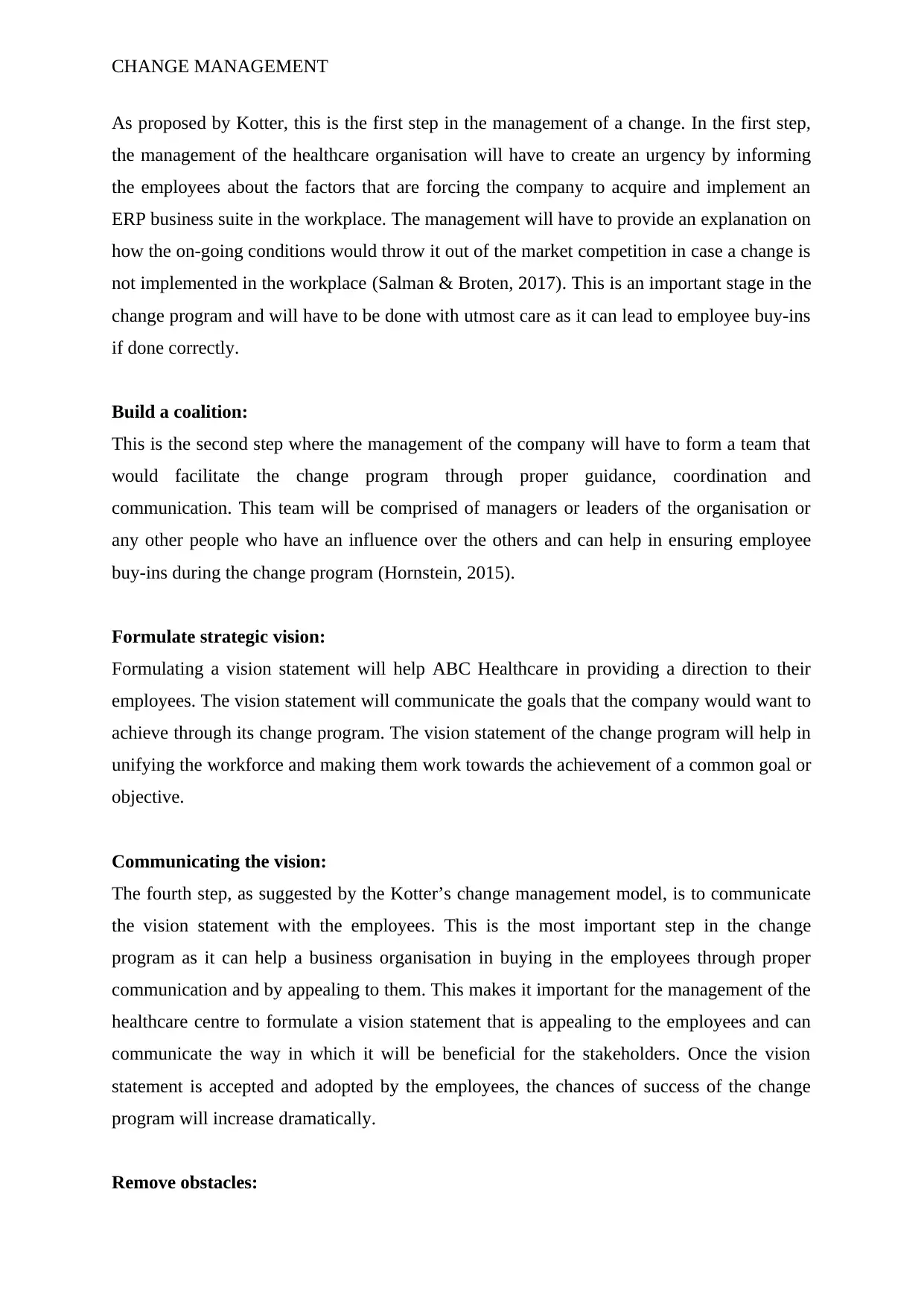
CHANGE MANAGEMENT
As proposed by Kotter, this is the first step in the management of a change. In the first step,
the management of the healthcare organisation will have to create an urgency by informing
the employees about the factors that are forcing the company to acquire and implement an
ERP business suite in the workplace. The management will have to provide an explanation on
how the on-going conditions would throw it out of the market competition in case a change is
not implemented in the workplace (Salman & Broten, 2017). This is an important stage in the
change program and will have to be done with utmost care as it can lead to employee buy-ins
if done correctly.
Build a coalition:
This is the second step where the management of the company will have to form a team that
would facilitate the change program through proper guidance, coordination and
communication. This team will be comprised of managers or leaders of the organisation or
any other people who have an influence over the others and can help in ensuring employee
buy-ins during the change program (Hornstein, 2015).
Formulate strategic vision:
Formulating a vision statement will help ABC Healthcare in providing a direction to their
employees. The vision statement will communicate the goals that the company would want to
achieve through its change program. The vision statement of the change program will help in
unifying the workforce and making them work towards the achievement of a common goal or
objective.
Communicating the vision:
The fourth step, as suggested by the Kotter’s change management model, is to communicate
the vision statement with the employees. This is the most important step in the change
program as it can help a business organisation in buying in the employees through proper
communication and by appealing to them. This makes it important for the management of the
healthcare centre to formulate a vision statement that is appealing to the employees and can
communicate the way in which it will be beneficial for the stakeholders. Once the vision
statement is accepted and adopted by the employees, the chances of success of the change
program will increase dramatically.
Remove obstacles:
As proposed by Kotter, this is the first step in the management of a change. In the first step,
the management of the healthcare organisation will have to create an urgency by informing
the employees about the factors that are forcing the company to acquire and implement an
ERP business suite in the workplace. The management will have to provide an explanation on
how the on-going conditions would throw it out of the market competition in case a change is
not implemented in the workplace (Salman & Broten, 2017). This is an important stage in the
change program and will have to be done with utmost care as it can lead to employee buy-ins
if done correctly.
Build a coalition:
This is the second step where the management of the company will have to form a team that
would facilitate the change program through proper guidance, coordination and
communication. This team will be comprised of managers or leaders of the organisation or
any other people who have an influence over the others and can help in ensuring employee
buy-ins during the change program (Hornstein, 2015).
Formulate strategic vision:
Formulating a vision statement will help ABC Healthcare in providing a direction to their
employees. The vision statement will communicate the goals that the company would want to
achieve through its change program. The vision statement of the change program will help in
unifying the workforce and making them work towards the achievement of a common goal or
objective.
Communicating the vision:
The fourth step, as suggested by the Kotter’s change management model, is to communicate
the vision statement with the employees. This is the most important step in the change
program as it can help a business organisation in buying in the employees through proper
communication and by appealing to them. This makes it important for the management of the
healthcare centre to formulate a vision statement that is appealing to the employees and can
communicate the way in which it will be beneficial for the stakeholders. Once the vision
statement is accepted and adopted by the employees, the chances of success of the change
program will increase dramatically.
Remove obstacles:
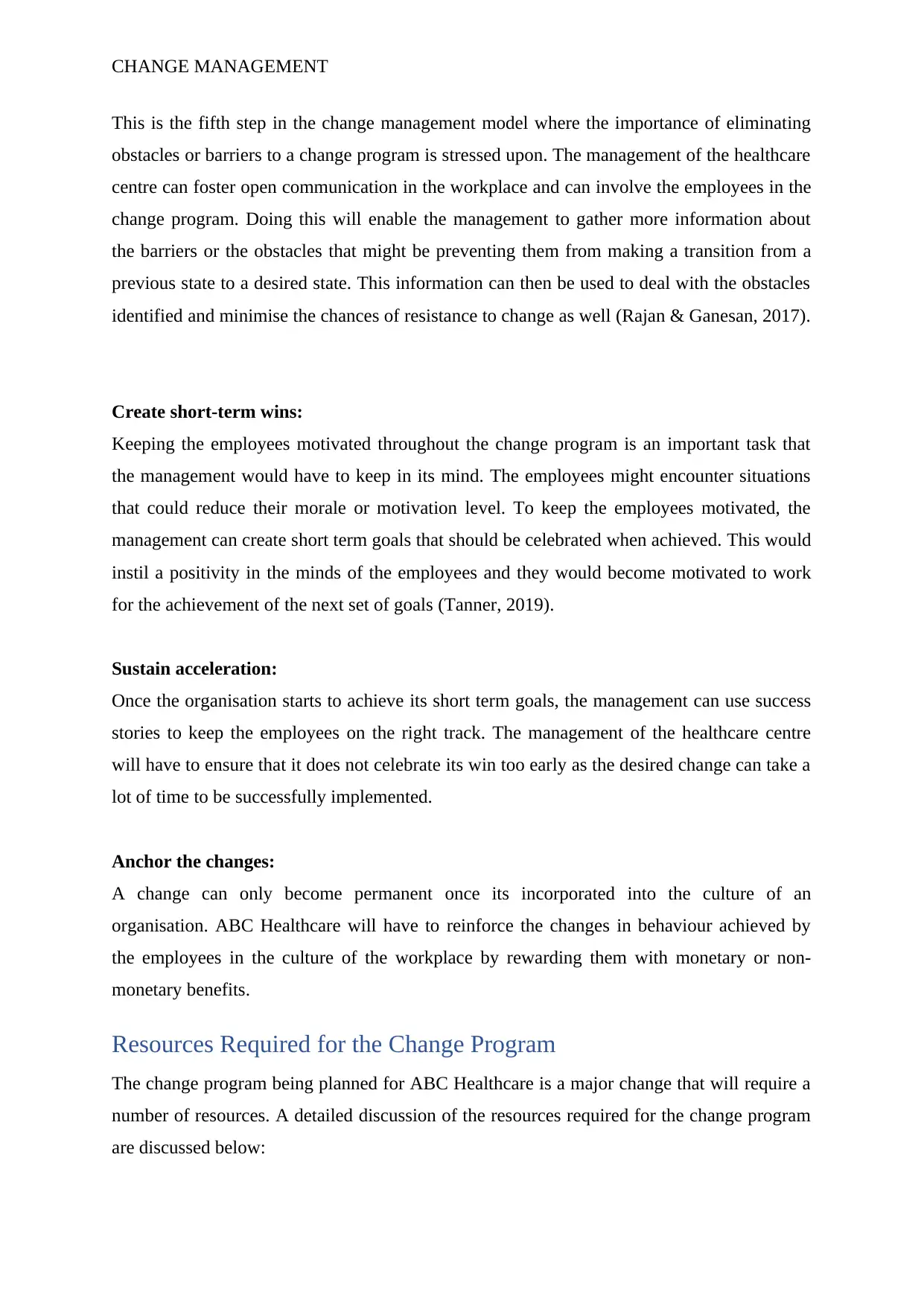
CHANGE MANAGEMENT
This is the fifth step in the change management model where the importance of eliminating
obstacles or barriers to a change program is stressed upon. The management of the healthcare
centre can foster open communication in the workplace and can involve the employees in the
change program. Doing this will enable the management to gather more information about
the barriers or the obstacles that might be preventing them from making a transition from a
previous state to a desired state. This information can then be used to deal with the obstacles
identified and minimise the chances of resistance to change as well (Rajan & Ganesan, 2017).
Create short-term wins:
Keeping the employees motivated throughout the change program is an important task that
the management would have to keep in its mind. The employees might encounter situations
that could reduce their morale or motivation level. To keep the employees motivated, the
management can create short term goals that should be celebrated when achieved. This would
instil a positivity in the minds of the employees and they would become motivated to work
for the achievement of the next set of goals (Tanner, 2019).
Sustain acceleration:
Once the organisation starts to achieve its short term goals, the management can use success
stories to keep the employees on the right track. The management of the healthcare centre
will have to ensure that it does not celebrate its win too early as the desired change can take a
lot of time to be successfully implemented.
Anchor the changes:
A change can only become permanent once its incorporated into the culture of an
organisation. ABC Healthcare will have to reinforce the changes in behaviour achieved by
the employees in the culture of the workplace by rewarding them with monetary or non-
monetary benefits.
Resources Required for the Change Program
The change program being planned for ABC Healthcare is a major change that will require a
number of resources. A detailed discussion of the resources required for the change program
are discussed below:
This is the fifth step in the change management model where the importance of eliminating
obstacles or barriers to a change program is stressed upon. The management of the healthcare
centre can foster open communication in the workplace and can involve the employees in the
change program. Doing this will enable the management to gather more information about
the barriers or the obstacles that might be preventing them from making a transition from a
previous state to a desired state. This information can then be used to deal with the obstacles
identified and minimise the chances of resistance to change as well (Rajan & Ganesan, 2017).
Create short-term wins:
Keeping the employees motivated throughout the change program is an important task that
the management would have to keep in its mind. The employees might encounter situations
that could reduce their morale or motivation level. To keep the employees motivated, the
management can create short term goals that should be celebrated when achieved. This would
instil a positivity in the minds of the employees and they would become motivated to work
for the achievement of the next set of goals (Tanner, 2019).
Sustain acceleration:
Once the organisation starts to achieve its short term goals, the management can use success
stories to keep the employees on the right track. The management of the healthcare centre
will have to ensure that it does not celebrate its win too early as the desired change can take a
lot of time to be successfully implemented.
Anchor the changes:
A change can only become permanent once its incorporated into the culture of an
organisation. ABC Healthcare will have to reinforce the changes in behaviour achieved by
the employees in the culture of the workplace by rewarding them with monetary or non-
monetary benefits.
Resources Required for the Change Program
The change program being planned for ABC Healthcare is a major change that will require a
number of resources. A detailed discussion of the resources required for the change program
are discussed below:
⊘ This is a preview!⊘
Do you want full access?
Subscribe today to unlock all pages.

Trusted by 1+ million students worldwide
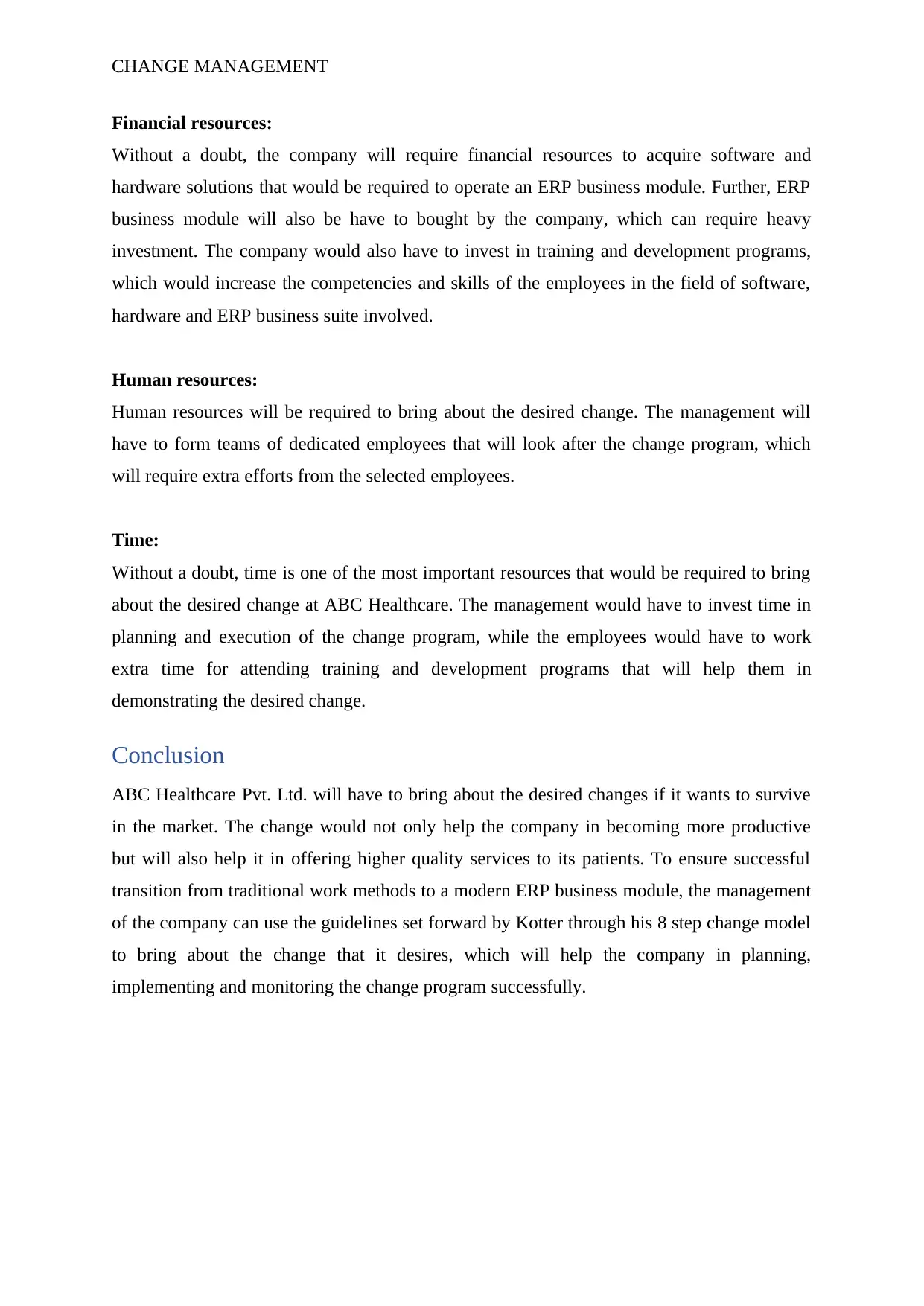
CHANGE MANAGEMENT
Financial resources:
Without a doubt, the company will require financial resources to acquire software and
hardware solutions that would be required to operate an ERP business module. Further, ERP
business module will also be have to bought by the company, which can require heavy
investment. The company would also have to invest in training and development programs,
which would increase the competencies and skills of the employees in the field of software,
hardware and ERP business suite involved.
Human resources:
Human resources will be required to bring about the desired change. The management will
have to form teams of dedicated employees that will look after the change program, which
will require extra efforts from the selected employees.
Time:
Without a doubt, time is one of the most important resources that would be required to bring
about the desired change at ABC Healthcare. The management would have to invest time in
planning and execution of the change program, while the employees would have to work
extra time for attending training and development programs that will help them in
demonstrating the desired change.
Conclusion
ABC Healthcare Pvt. Ltd. will have to bring about the desired changes if it wants to survive
in the market. The change would not only help the company in becoming more productive
but will also help it in offering higher quality services to its patients. To ensure successful
transition from traditional work methods to a modern ERP business module, the management
of the company can use the guidelines set forward by Kotter through his 8 step change model
to bring about the change that it desires, which will help the company in planning,
implementing and monitoring the change program successfully.
Financial resources:
Without a doubt, the company will require financial resources to acquire software and
hardware solutions that would be required to operate an ERP business module. Further, ERP
business module will also be have to bought by the company, which can require heavy
investment. The company would also have to invest in training and development programs,
which would increase the competencies and skills of the employees in the field of software,
hardware and ERP business suite involved.
Human resources:
Human resources will be required to bring about the desired change. The management will
have to form teams of dedicated employees that will look after the change program, which
will require extra efforts from the selected employees.
Time:
Without a doubt, time is one of the most important resources that would be required to bring
about the desired change at ABC Healthcare. The management would have to invest time in
planning and execution of the change program, while the employees would have to work
extra time for attending training and development programs that will help them in
demonstrating the desired change.
Conclusion
ABC Healthcare Pvt. Ltd. will have to bring about the desired changes if it wants to survive
in the market. The change would not only help the company in becoming more productive
but will also help it in offering higher quality services to its patients. To ensure successful
transition from traditional work methods to a modern ERP business module, the management
of the company can use the guidelines set forward by Kotter through his 8 step change model
to bring about the change that it desires, which will help the company in planning,
implementing and monitoring the change program successfully.
Paraphrase This Document
Need a fresh take? Get an instant paraphrase of this document with our AI Paraphraser
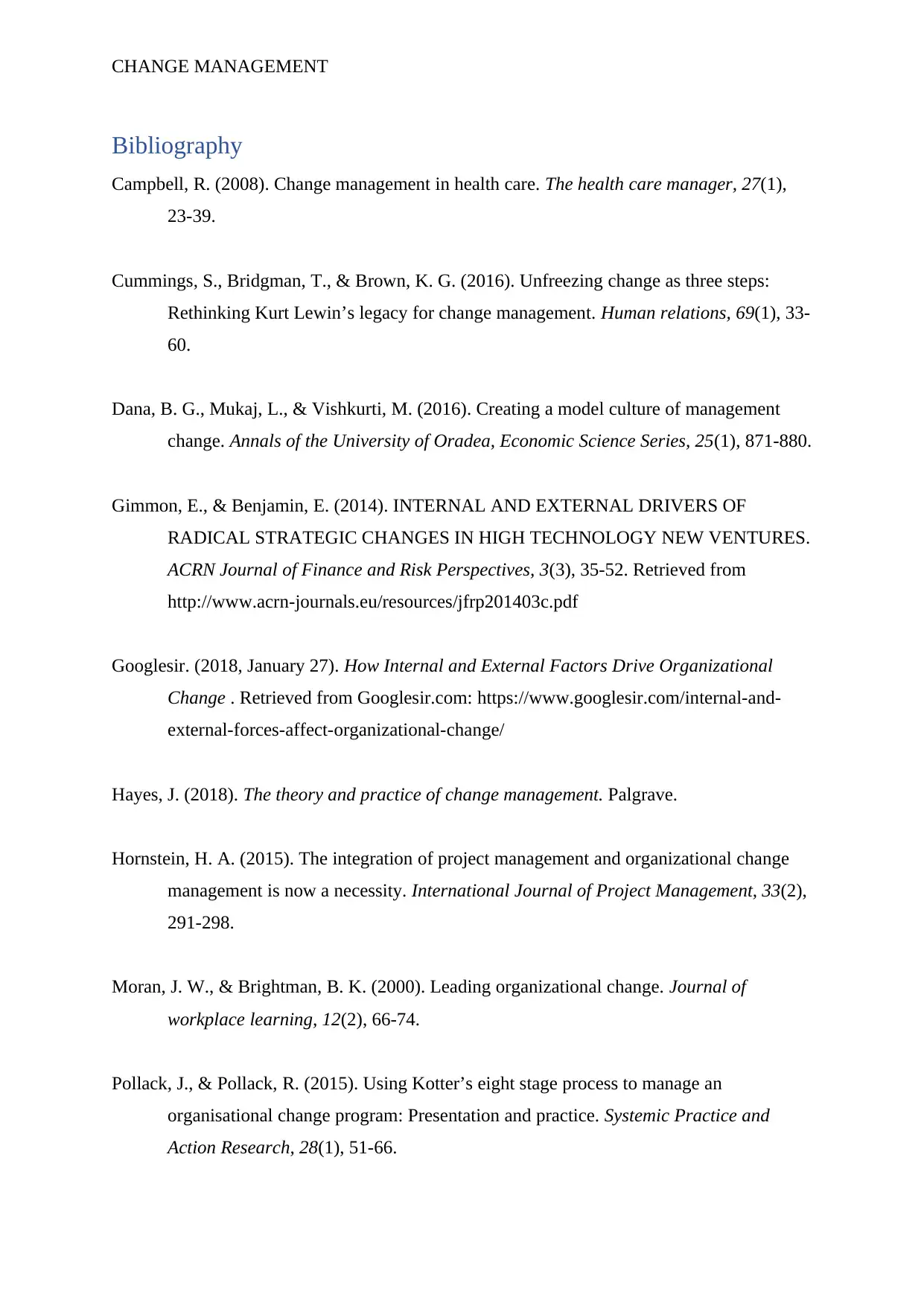
CHANGE MANAGEMENT
Bibliography
Campbell, R. (2008). Change management in health care. The health care manager, 27(1),
23-39.
Cummings, S., Bridgman, T., & Brown, K. G. (2016). Unfreezing change as three steps:
Rethinking Kurt Lewin’s legacy for change management. Human relations, 69(1), 33-
60.
Dana, B. G., Mukaj, L., & Vishkurti, M. (2016). Creating a model culture of management
change. Annals of the University of Oradea, Economic Science Series, 25(1), 871-880.
Gimmon, E., & Benjamin, E. (2014). INTERNAL AND EXTERNAL DRIVERS OF
RADICAL STRATEGIC CHANGES IN HIGH TECHNOLOGY NEW VENTURES.
ACRN Journal of Finance and Risk Perspectives, 3(3), 35-52. Retrieved from
http://www.acrn-journals.eu/resources/jfrp201403c.pdf
Googlesir. (2018, January 27). How Internal and External Factors Drive Organizational
Change . Retrieved from Googlesir.com: https://www.googlesir.com/internal-and-
external-forces-affect-organizational-change/
Hayes, J. (2018). The theory and practice of change management. Palgrave.
Hornstein, H. A. (2015). The integration of project management and organizational change
management is now a necessity. International Journal of Project Management, 33(2),
291-298.
Moran, J. W., & Brightman, B. K. (2000). Leading organizational change. Journal of
workplace learning, 12(2), 66-74.
Pollack, J., & Pollack, R. (2015). Using Kotter’s eight stage process to manage an
organisational change program: Presentation and practice. Systemic Practice and
Action Research, 28(1), 51-66.
Bibliography
Campbell, R. (2008). Change management in health care. The health care manager, 27(1),
23-39.
Cummings, S., Bridgman, T., & Brown, K. G. (2016). Unfreezing change as three steps:
Rethinking Kurt Lewin’s legacy for change management. Human relations, 69(1), 33-
60.
Dana, B. G., Mukaj, L., & Vishkurti, M. (2016). Creating a model culture of management
change. Annals of the University of Oradea, Economic Science Series, 25(1), 871-880.
Gimmon, E., & Benjamin, E. (2014). INTERNAL AND EXTERNAL DRIVERS OF
RADICAL STRATEGIC CHANGES IN HIGH TECHNOLOGY NEW VENTURES.
ACRN Journal of Finance and Risk Perspectives, 3(3), 35-52. Retrieved from
http://www.acrn-journals.eu/resources/jfrp201403c.pdf
Googlesir. (2018, January 27). How Internal and External Factors Drive Organizational
Change . Retrieved from Googlesir.com: https://www.googlesir.com/internal-and-
external-forces-affect-organizational-change/
Hayes, J. (2018). The theory and practice of change management. Palgrave.
Hornstein, H. A. (2015). The integration of project management and organizational change
management is now a necessity. International Journal of Project Management, 33(2),
291-298.
Moran, J. W., & Brightman, B. K. (2000). Leading organizational change. Journal of
workplace learning, 12(2), 66-74.
Pollack, J., & Pollack, R. (2015). Using Kotter’s eight stage process to manage an
organisational change program: Presentation and practice. Systemic Practice and
Action Research, 28(1), 51-66.
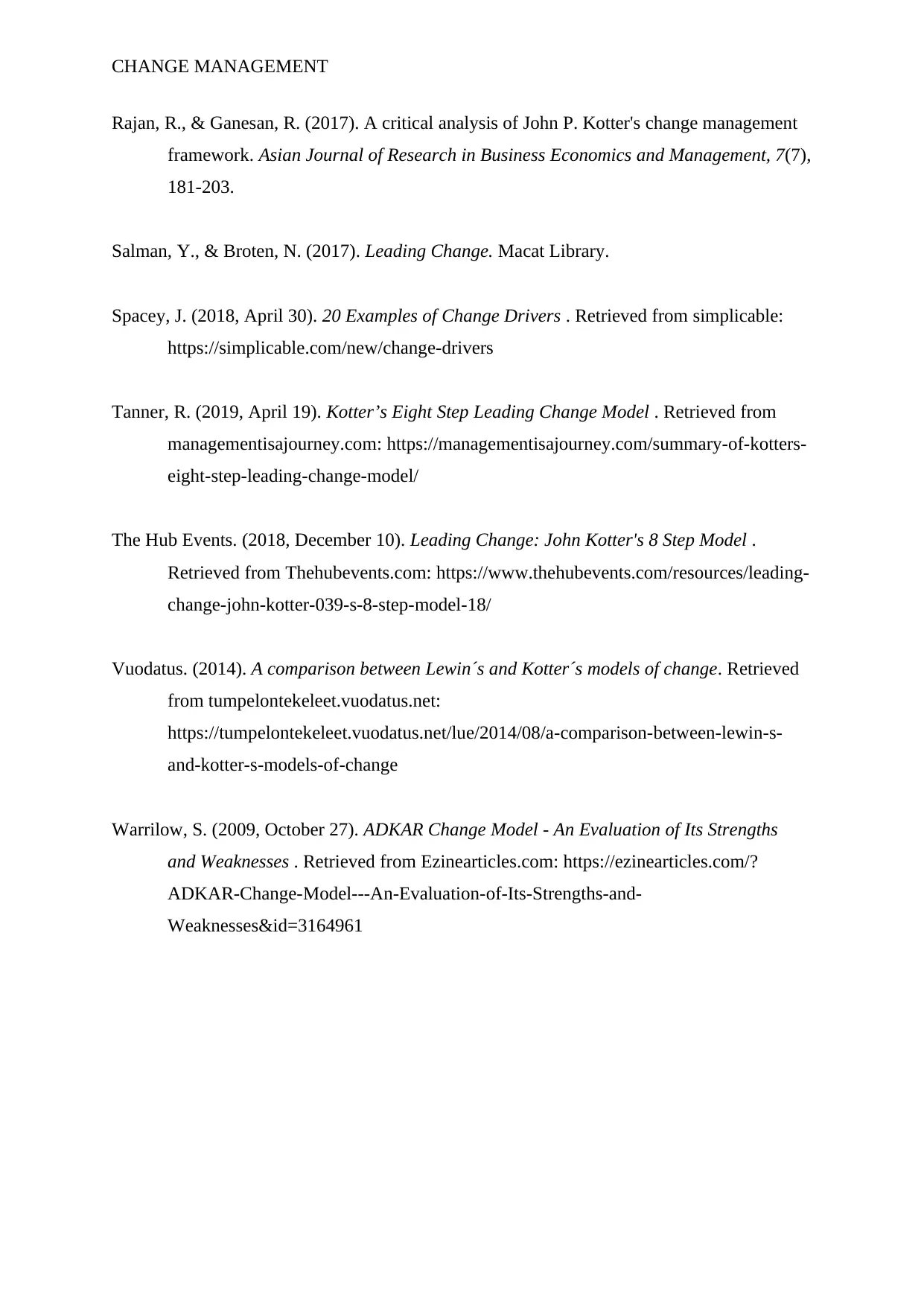
CHANGE MANAGEMENT
Rajan, R., & Ganesan, R. (2017). A critical analysis of John P. Kotter's change management
framework. Asian Journal of Research in Business Economics and Management, 7(7),
181-203.
Salman, Y., & Broten, N. (2017). Leading Change. Macat Library.
Spacey, J. (2018, April 30). 20 Examples of Change Drivers . Retrieved from simplicable:
https://simplicable.com/new/change-drivers
Tanner, R. (2019, April 19). Kotter’s Eight Step Leading Change Model . Retrieved from
managementisajourney.com: https://managementisajourney.com/summary-of-kotters-
eight-step-leading-change-model/
The Hub Events. (2018, December 10). Leading Change: John Kotter's 8 Step Model .
Retrieved from Thehubevents.com: https://www.thehubevents.com/resources/leading-
change-john-kotter-039-s-8-step-model-18/
Vuodatus. (2014). A comparison between Lewin´s and Kotter´s models of change. Retrieved
from tumpelontekeleet.vuodatus.net:
https://tumpelontekeleet.vuodatus.net/lue/2014/08/a-comparison-between-lewin-s-
and-kotter-s-models-of-change
Warrilow, S. (2009, October 27). ADKAR Change Model - An Evaluation of Its Strengths
and Weaknesses . Retrieved from Ezinearticles.com: https://ezinearticles.com/?
ADKAR-Change-Model---An-Evaluation-of-Its-Strengths-and-
Weaknesses&id=3164961
Rajan, R., & Ganesan, R. (2017). A critical analysis of John P. Kotter's change management
framework. Asian Journal of Research in Business Economics and Management, 7(7),
181-203.
Salman, Y., & Broten, N. (2017). Leading Change. Macat Library.
Spacey, J. (2018, April 30). 20 Examples of Change Drivers . Retrieved from simplicable:
https://simplicable.com/new/change-drivers
Tanner, R. (2019, April 19). Kotter’s Eight Step Leading Change Model . Retrieved from
managementisajourney.com: https://managementisajourney.com/summary-of-kotters-
eight-step-leading-change-model/
The Hub Events. (2018, December 10). Leading Change: John Kotter's 8 Step Model .
Retrieved from Thehubevents.com: https://www.thehubevents.com/resources/leading-
change-john-kotter-039-s-8-step-model-18/
Vuodatus. (2014). A comparison between Lewin´s and Kotter´s models of change. Retrieved
from tumpelontekeleet.vuodatus.net:
https://tumpelontekeleet.vuodatus.net/lue/2014/08/a-comparison-between-lewin-s-
and-kotter-s-models-of-change
Warrilow, S. (2009, October 27). ADKAR Change Model - An Evaluation of Its Strengths
and Weaknesses . Retrieved from Ezinearticles.com: https://ezinearticles.com/?
ADKAR-Change-Model---An-Evaluation-of-Its-Strengths-and-
Weaknesses&id=3164961
⊘ This is a preview!⊘
Do you want full access?
Subscribe today to unlock all pages.

Trusted by 1+ million students worldwide
1 out of 12
Related Documents
Your All-in-One AI-Powered Toolkit for Academic Success.
+13062052269
info@desklib.com
Available 24*7 on WhatsApp / Email
![[object Object]](/_next/static/media/star-bottom.7253800d.svg)
Unlock your academic potential
Copyright © 2020–2025 A2Z Services. All Rights Reserved. Developed and managed by ZUCOL.




